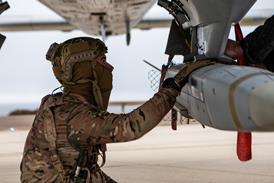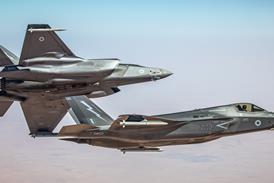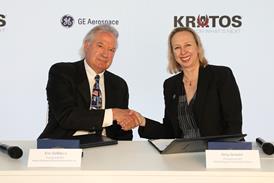Stewart Penney/LONDON
South Africa's Air Force is celebrating its 80th anniversary while it continues to adapt to the new political reality within the country.

At the same time it is managing the transition to a new force structure reflective of the post-apartheid South Africa's regional role and preparing for a major re-equipment programme. The SAAF last year signed deals for Saab/BAE Systems Gripen fighters, BAE Hawk advanced trainers and Agusta A109 helicopters.
Lt Gen Roelf Beukes, chief of the air force, says that at the start of this year the air force board considered the SAAF's future. "It's six years since [Nelson Mandela's] election and we had just entered a new millennium. We took stock and asked where are we going in the next 10 years?" The answer is, he says, "in 10 years' time we want to be an air power centre of excellence: combat ready, well trained and representative of the nation."
Combat ready, he continues, means not only the aircrews but the whole air force including "the guard on the main gate, the chef in the mess, the air traffic controller and everybody else". Each must be well trained and empowered to do the job, says Beukes. While the air force is working hard to achieve its aims, he warns, "flying standards and safety are not negotiable."

There needs to be an ethnic mix within the SAAF that is representative of South Africa. "We fully support the transition to representation that reflects the demographic reality of the nation. We must advance those with potential and commitment, be fair and uphold standards." At the same time "we also have to make 100% sure that" personnel are equipped to operate and maintain current equipment as well as the new systems due to enter service over the next ten years.
The SAAF has had some success. In 1994 only 17% of the air force was non-white, and had only three black officers, today 39% of the force is non-white and there are more than 300 black officers. There is still, however, some way to go - around 13% of the total population is white, and more than 75% of the population is black. He says "we're moving in the right direction," adding that the air force should be representative across the specialisations, including aircrew and technical disciplines.
Although recruitment levels are good, there is a need to ensure that the right balance of race and gender are achieved, says Beukes. In July last year an Air Force Recruitment Steering Committee was established to review recruitment procedures. It is working on four initiatives to improve black recruitment: first, says Beukes, the air force wants to make the black population more aviation-aware. Second it has reviewed the recruitment process, how it works and where it is located: "The whole system was designed for the white population," he says. The situation is similar for pilot selection: "We are looking at new procedures."
Removing The Imbalance
The SAAF is also working to remove the imbalance created by the differing school systems. "We've realised that we need to spend time in preparatory training so that when the day comes to start flying training, everybody will have the same chance of qualifying." Where necessary, additional mathematics and physics schooling will be given before a pupil joins the flying training system. As a result of the initiatives Beukes says "we've made more progress in one year than the previous five."
One of Beukes' key tasks is to supply aircraft to the chief of joint operations - who like Beukes answers to the chief of the South African National Defence Force - for operational employment. In February, the SAAF took part in the humanitarian operation in Mozambique following the devastation caused by Cyclone Eline. The task force commander was an air force lieutenant colonel, but it could equally be an army or naval officer, says Beukes. Initially, the SAAF deployed five helicopters and three fixed-wing aircraft. The number of helicopters later increased to seven while an extra fixed wing aircraft was also added. It also worked with UK and US forces during the crises.
South Africa's political transformation means that it has been able to establish links with its near neighbours, previously opposed to the country. Joint operations with other southern African nations will tend to be peacekeeping and humanitarian aid, says Beukes, who recently became the first head of the SAAF to visit Zambia. The next possible deployment is to the Democratic Republic of Congo as part of a United Nations' peacekeeping operation.
In recent years the SAAF has participated in joint exercises in Zimbabwe and it hosted an exercise last year. The SAAF is also part of an 11-strong association of southern African states - including Botswana, Lesotho and Namibia - which have links on training, operations, logistics and safety, with the SAAF chairing the latter committee. The last meeting was held in July. The growing co-operation within southern Africa could lead to joint training, he says.
Beukes says the SAAF's procurement programmes are proceeding well and that it has created project offices in Italy to manage the A109 buy and in the UK for the Hawk purchase. A Gripen project office is to be established in Sweden in January he adds.
In September last year South Africa signed for nine two-seat Gripens and options for 19 single-seaters; 12 Hawk lead-in fighter trainers and 12 options; and 30 A109s with 10 options.
The A109s are due to enter service in 2003, to replace Aerospatiale Alouette IIIs in training and communications tasks. The Hawk enters service in 2005, supplanting Atlas Impalas, a licence built version of the Aermacchi MB326.
The Gripen is to enter service in 2007, replacing the Denel Cheetah C/D, a South African/Israeli development of the Dassault Mirage III. An international arms embargo against South Africa during the apartheid era forced the country to establish its own weapons development capability, and the Gripen and Hawk will be equipped with a range of indigenous weapons. Also entering service with the SAAF is the Denel Rooivalk attack helicopter.
Outstanding Requirement
An outstanding requirement is for four maritime helicopters to operate from a similar number of corvettes ordered at the same time as the aircraft. Beukes expects a decision in October or November on whether the programme will go ahead with a order for the preferred bidder, the GKN Westland Super Lynx 300, or if a new competition will be started.
One role South Africa needs to update is maritime patrol, undertaken today by DouglasC-47s re-engined with turboprop engines. Beukes says the SAAF is aware of the need to improve its maritime patrol capabilities, adding that the role is "strategically important for us." Casa has supplied South Africa with data on maritime patrol versions of the CN235 and C295 transports (Flight International 9-15 April). Beukes says, however, it is too early to say whether the maritime patrol aircraft will have commonality with a transport. No decision will be taken in the near term.
The SAAF also needs to improve its transport capabilities, with more aircraft in the Casa 212/CN235 class needed. It has four C212s and a single CN235, a capability "which we need to expand", although, he says a new type could be selected. Meanwhile the air force is preparing to receive its first upgraded Lockheed MartinC-130 Hercules in January next year. The first aircraft is in flight test, having been equipped with Sextant avionics and cockpit displays by the UK's Marshall Aerospace.
Despite the challenges, Beukes is confident that the SAAF's revised recruitment plans will lead to an air force representative of the South African population while the country's acquisition plans should give the SAAF the equipment to become an air power centre of excellence.
Source: Flight International























